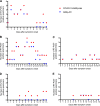Improved Molecular Diagnosis of COVID-19 by the Novel, Highly Sensitive and Specific COVID-19-RdRp/Hel Real-Time Reverse Transcription-PCR Assay Validated In Vitro and with Clinical Specimens
- PMID: 32132196
- PMCID: PMC7180250
- DOI: 10.1128/JCM.00310-20
Improved Molecular Diagnosis of COVID-19 by the Novel, Highly Sensitive and Specific COVID-19-RdRp/Hel Real-Time Reverse Transcription-PCR Assay Validated In Vitro and with Clinical Specimens
Abstract
On 31 December 2019, the World Health Organization was informed of a cluster of cases of pneumonia of unknown etiology in Wuhan, China. Subsequent investigations identified a novel coronavirus, now named severe acute respiratory syndrome coronavirus 2 (SARS-CoV-2), from the affected patients. Highly sensitive and specific laboratory diagnostics are important for controlling the rapidly evolving SARS-CoV-2-associated coronavirus disease 2019 (COVID-19) epidemic. In this study, we developed and compared the performance of three novel real-time reverse transcription-PCR (RT-PCR) assays targeting the RNA-dependent RNA polymerase (RdRp)/helicase (Hel), spike (S), and nucleocapsid (N) genes of SARS-CoV-2 with that of the reported RdRp-P2 assay, which is used in >30 European laboratories. Among the three novel assays, the COVID-19-RdRp/Hel assay had the lowest limit of detection in vitro (1.8 50% tissue culture infective doses [TCID50]/ml with genomic RNA and 11.2 RNA copies/reaction with in vitro RNA transcripts). Among 273 specimens from 15 patients with laboratory-confirmed COVID-19 in Hong Kong, 77 (28.2%) were positive by both the COVID-19-RdRp/Hel and RdRp-P2 assays. The COVID-19-RdRp/Hel assay was positive for an additional 42 RdRp-P2-negative specimens (119/273 [43.6%] versus 77/273 [28.2%]; P < 0.001), including 29/120 (24.2%) respiratory tract specimens and 13/153 (8.5%) non-respiratory tract specimens. The mean viral load of these specimens was 3.21 × 104 RNA copies/ml (range, 2.21 × 102 to 4.71 × 105 RNA copies/ml). The COVID-19-RdRp/Hel assay did not cross-react with other human-pathogenic coronaviruses and respiratory pathogens in cell culture and clinical specimens, whereas the RdRp-P2 assay cross-reacted with SARS-CoV in cell culture. The highly sensitive and specific COVID-19-RdRp/Hel assay may help to improve the laboratory diagnosis of COVID-19.
Keywords: COVID-19; PCR; SARS; Wuhan; coronavirus; diagnostic; emerging; virus.
Copyright © 2020 Chan et al.
Figures

Similar articles
-
Development and Evaluation of Novel and Highly Sensitive Single-Tube Nested Real-Time RT-PCR Assays for SARS-CoV-2 Detection.Int J Mol Sci. 2020 Aug 7;21(16):5674. doi: 10.3390/ijms21165674. Int J Mol Sci. 2020. PMID: 32784770 Free PMC article.
-
Clinical Performance of the Luminex NxTAG CoV Extended Panel for SARS-CoV-2 Detection in Nasopharyngeal Specimens from COVID-19 Patients in Hong Kong.J Clin Microbiol. 2020 Jul 23;58(8):e00936-20. doi: 10.1128/JCM.00936-20. Print 2020 Jul 23. J Clin Microbiol. 2020. PMID: 32482633 Free PMC article.
-
A reverse-transcription recombinase-aided amplification assay for the rapid detection of N gene of severe acute respiratory syndrome coronavirus 2(SARS-CoV-2).Virology. 2020 Oct;549:1-4. doi: 10.1016/j.virol.2020.07.006. Epub 2020 Jul 29. Virology. 2020. PMID: 32758712 Free PMC article.
-
[SARS-CoV-2 and Microbiological Diagnostic Dynamics in COVID-19 Pandemic].Mikrobiyol Bul. 2020 Jul;54(3):497-509. doi: 10.5578/mb.69839. Mikrobiyol Bul. 2020. PMID: 32755524 Review. Turkish.
-
The diagnostic methods in the COVID-19 pandemic, today and in the future.Expert Rev Mol Diagn. 2020 Sep;20(9):985-993. doi: 10.1080/14737159.2020.1816171. Epub 2020 Sep 16. Expert Rev Mol Diagn. 2020. PMID: 32845192 Review.
Cited by
-
M protein ectodomain-specific immunity restrains SARS-CoV-2 variants replication.Front Immunol. 2024 Oct 2;15:1450114. doi: 10.3389/fimmu.2024.1450114. eCollection 2024. Front Immunol. 2024. PMID: 39416782 Free PMC article.
-
Folded flexure MOEMS for the detection of PSA and hepatitis DNA as biosensor for prostate cancer and viruses.Sci Rep. 2024 Oct 2;14(1):22881. doi: 10.1038/s41598-024-73910-x. Sci Rep. 2024. PMID: 39358419 Free PMC article.
-
Ultrapotent class I neutralizing antibodies post Omicron breakthrough infection overcome broad SARS-CoV-2 escape variants.EBioMedicine. 2024 Oct;108:105354. doi: 10.1016/j.ebiom.2024.105354. Epub 2024 Sep 27. EBioMedicine. 2024. PMID: 39341153 Free PMC article.
-
Dynamic changes of hematological and hemostatic parameters in COVID-19 hospitalized patients: Potential role as severity biomarkers for the Chilean population.J Med Biochem. 2024 Jun 15;43(4):556-564. doi: 10.5937/jomb0-47588. J Med Biochem. 2024. PMID: 39139154 Free PMC article.
-
Engineering a "muco-trapping" ACE2-immunoglobulin hybrid with picomolar affinity as an inhaled, pan-variant immunotherapy for COVID-19.Bioeng Transl Med. 2024 Feb 7;9(4):e10650. doi: 10.1002/btm2.10650. eCollection 2024 Jul. Bioeng Transl Med. 2024. PMID: 39036085 Free PMC article.
References
-
- Zhu N, Zhang D, Wang W, Li X, Yang B, Song J, Zhao X, Huang B, Shi W, Lu R, Niu P, Zhan F, Ma X, Wang D, Xu W, Wu G, Gao GF, Tan W, China Novel Coronavirus Investigating and Research Team>. 2020. A novel coronavirus from patients with pneumonia in China, 2019. N Engl J Med 382:727–733. doi:10.1056/NEJMoa2001017. - DOI - PMC - PubMed
-
- Chan JF, Yuan S, Kok KH, To KK, Chu H, Yang J, Xing F, Liu J, Yip CC, Poon RW, Tsoi HW, Lo SK, Chan KH, Poon VK, Chan WM, Ip JD, Cai JP, Cheng VC, Chen H, Hui CK, Yuen KY. 2020. A familial cluster of pneumonia associated with the 2019 novel coronavirus indicating person-to-person transmission: a study of a family cluster. Lancet 395:514–523. doi:10.1016/S0140-6736(20)30154-9. - DOI - PMC - PubMed
-
- Zhou P, Yang XL, Wang XG, Hu B, Zhang L, Zhang W, Si HR, Zhu Y, Li B, Huang CL, Chen HD, Chen J, Luo Y, Guo H, Jiang RD, Liu MQ, Chen Y, Shen XR, Wang X, Zheng XS, Zhao K, Chen QJ, Deng F, Liu LL, Yan B, Zhan FX, Wang YY, Xiao GF, Shi ZL. 3 February 2020. A pneumonia outbreak associated with a new coronavirus of probable bat origin. Nature doi:10.1038/s41586-020-2012-7. - DOI - PMC - PubMed
-
- Huang C, Wang Y, Li X, Ren L, Zhao J, Hu Y, Zhang L, Fan G, Xu J, Gu X, Cheng Z, Yu T, Xia J, Wei Y, Wu W, Xie X, Yin W, Li H, Liu M, Xiao Y, Gao H, Guo L, Xie J, Wang G, Jiang R, Gao Z, Jin Q, Wang J, Cao B. 2020. Clinical features of patients infected with 2019 novel coronavirus in Wuhan, China. Lancet 395:497–506. doi:10.1016/S0140-6736(20)30183-5. - DOI - PMC - PubMed
Publication types
MeSH terms
Substances
LinkOut - more resources
Full Text Sources
Other Literature Sources
Medical
Research Materials
Miscellaneous

